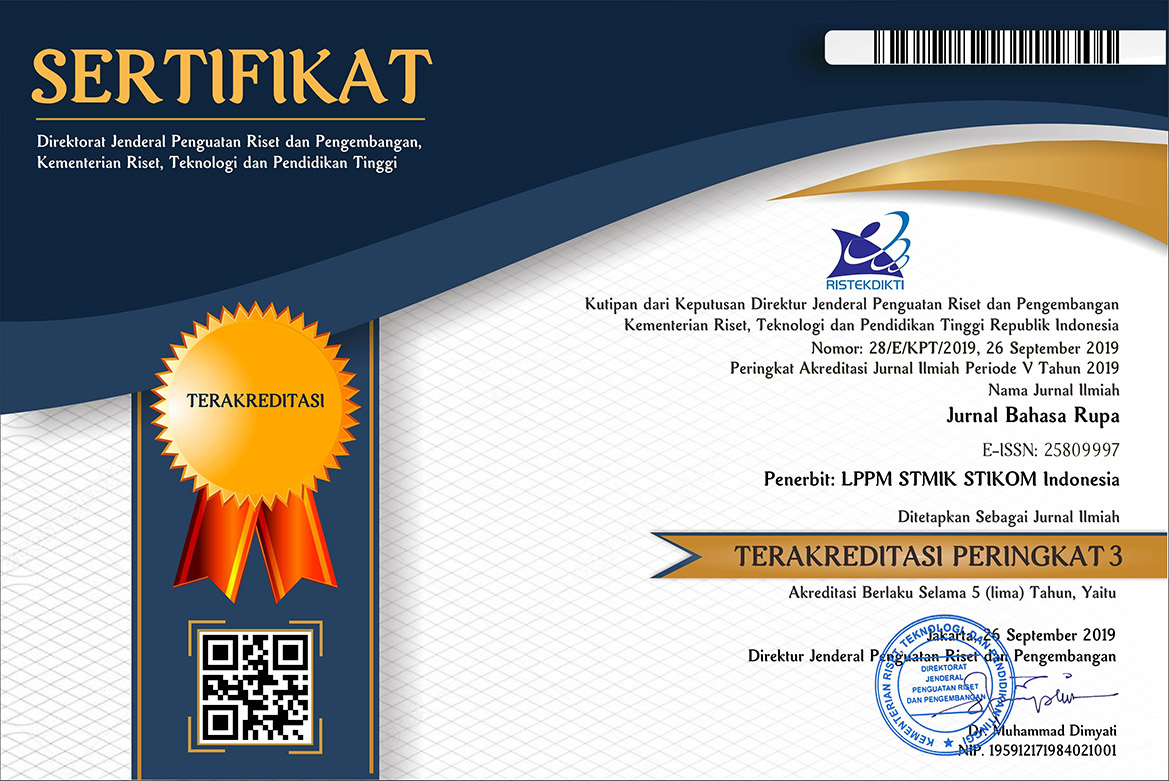Perkembangan Penelitian Tipografi: Kajian Bibliometrik
DOI:
https://doi.org/10.31598/bahasarupa.v6i2.1307Keywords:
developments, trends, typography, bibliometricsAbstract
An essential component of visual communication design is typography. Moreover, research on typography has been done in the past from both the standpoints of study and creation. Yet, there has never been research done on examining the development trend of studies on the subject of typography. Therefore, the following research questions were addressed: (1) What are the trends in research productivity regarding to typography topics based on year, publication source, affiliation, country, citation, and authorship from year to year? and (2) How is the development of research themes regarding to typography research from year to year? To conducted the research question, this research used the bibliometric method. Based on the keyword "typography" in the Scopus database, the information was retrieved, then examined and visualized using the Vos Viewer. The study's findings indicate that there has been a noticeable increase in typographic research from 1854 to 2022 in the Scopus database. Tiny nodes show up as a result of the co-occurrence visualization, indicating that there are still unique potential for research on typography-related issues. In the eight clusters, these tiny nodes are dispersed outside of the big nodes (red, green, blue, yellow, orange, brown, light blue, and purple clusters). Research possibilities with typography topics that contain the novelty can also be produced from new research that has been indexed in the Scopus database, in addition to being based on these tiny nodes.
Downloads
References
L. Anggraini S and K. Nathalia, Desain Komunikasi Visual: Dasar-Dasar Panduan Untuk Pemula. Bandung: Nuansa Cendekia, 2014.
N. Noordyanto, “Studi Tipografi Kawasan Di Yogyakarta,” Jurnal Dekave , vol. 9, no. 1, pp. 65–84, 2016.
D. Setiautami, “Eksperimen Tipografi dalam Visual untuk Anak,” Humaniora, vol. 2, no. 1, p. 311, Apr. 2011, doi: 10.21512/humaniora.v2i1.3011.
R. Purba, “Tipografi Kreasi Motif Gorga Batak,” PROPORSI : Jurnal Desain, Multimedia dan Industri Kreatif, vol. 1, no. 2, pp. 190–201, May 2016, doi: 10.22303/proporsi.1.2.2016.190-201.
Y. A. L. Hermanto, “IDENTIFIKASI ILUSTRASI-TIPOGRAFI GRAPHIC VERNACULAR SEBAGAI SISTEM TANDA & IDENTITAS WARUNG TENDA DI KOTA MALANG,” JADECS, vol. 3, no. 2, 2018.
E. Sumarni and Nihayati, “Kajian Bibliometrik dan Sebaran Topik Penelitian Pada Jurnal Standardisasi Terbitan Tahun 2013-2017,” in Seminar Kepustakawanan LPNK Ristek, 2018.
M. Trinidad, M. Ruiz, and A. Calderon, “A Bibliometric Analysis of Gamification Research,” IEEE Access, vol. 9, pp. 46505–46544, 2021, doi: 10.1109/ACCESS.2021.3063986.
I. Sajovic and B. Boh Podgornik, “Bibliometric Analysis of Visualizations in Computer Graphics: A Study,” Sage Open, vol. 12, no. 1, p. 215824402110711, Jan. 2022, doi: 10.1177/21582440211071105.
F. I. Maulana, F. Permana, R. Herasmara, P. F. Candra, and Khaeruddin, “Mapping Research Trends and Vizualization of E-Learning in Entrepreneurship in the Last Ten Years,” in IEIT 2021: 1st International Conference on Electrical and Information Technology, 2021, pp. 99–105. doi: 10.1109/IEIT53149.2021.9587376.
F. B. Viégas, M. Wattenberg, and J. Feinberg, “Participatory visualization with wordle,” IEEE Trans Vis Comput Graph, vol. 15, no. 6, pp. 1137–1144, 2009, doi: 10.1109/TVCG.2009.171.
O. Ampuero and N. Vila, “Consumer perceptions of product packaging,” Journal of Consumer Marketing, vol. 23, no. 2, pp. 102–114, 2006, doi: 10.1108/07363760610655032.
T. van Leeuwen, “Towards a semiotics of typography,” Information Design Journal, vol. 14, no. 2, pp. 139–155, 2006, doi: 10.1075/idj.14.2.06lee.
D. Freitag, “Machine learning for information extraction in informal domains,” Mach Learn, vol. 39, no. 2, pp. 169–202, 2000, doi: 10.1023/a:1007601113994.
G. E. Legge and C. A. Bigelow, “Does print size matter for reading? A review of findings from vision science and typography,” J Vis, vol. 11, no. 5, pp. 1–22, 2011, doi: 10.1167/11.5.1.
K. A. Grant, X. Leng, H. L. Green, K. T. Szeliga, L. S. M. Rogers, and S. W. Gonzales, “Drinking typography established by scheduled induction predicts chronic heavy drinking in a monkey model of ethanol self-administration,” Alcohol Clin Exp Res, vol. 32, no. 10, pp. 1824–1838, 2008, doi: 10.1111/j.1530-0277.2008.00765.x.
P. A. Kolers, “Memorial consequences of automatized encoding,” J Exp Psychol Hum Learn, vol. 1, no. 6, pp. 689–701, 1975, doi: 10.1037/0278-7393.1.6.689.
M. C. Dyson, “The influence of reading speed and line length on the effectiveness of reading from screen,” International Journal of Human Computer Studies, vol. 54, no. 4, pp. 585–612, 2001, doi: 10.1006/ijhc.2001.0458.
N. Cawthon and A. v Moere, “The effect of aesthetic on the usability of data visualization,” 2007, pp. 637–645. doi: 10.1109/IV.2007.147.
S. Lee and R. J. Koubek, “The effects of usability and web design attributes on user preference for e-commerce web sites,” Comput Ind, vol. 61, no. 4, pp. 329–341, 2010, doi: 10.1016/j.compind.2009.12.004.
Downloads
Published
How to Cite
Issue
Section
License
Copyright (c) 2023 Citra Fadillah Santoso

This work is licensed under a Creative Commons Attribution-NonCommercial-ShareAlike 4.0 International License.
The author's copyright in the Bahasa Rupa Journal, assigns that the publication of published articles is owned by the editorial board with the author's approval, but the rights are still with the author. The legal rules for accessing digital electronic articles are under license  Attribution-NonCommercial-ShareAlike 4.0 International (CC BY-NC-SA 4.0), which means that the Bahasa Rupa Journal has the right to store, modify, manage databases, maintain and publish articles without the author's permission, but the author as the copyright holder is still written as it is. Articles published in Bahasa Rupa Journals, both in hard and soft copy forms are available as open access, for educational, research and library purposes, and beyond that purpose, the editorial board of the Language and Language Journal is not responsible for illegal copyright infringement. This journal also applies LOCKSS and CLOKSS archiving.
Attribution-NonCommercial-ShareAlike 4.0 International (CC BY-NC-SA 4.0), which means that the Bahasa Rupa Journal has the right to store, modify, manage databases, maintain and publish articles without the author's permission, but the author as the copyright holder is still written as it is. Articles published in Bahasa Rupa Journals, both in hard and soft copy forms are available as open access, for educational, research and library purposes, and beyond that purpose, the editorial board of the Language and Language Journal is not responsible for illegal copyright infringement. This journal also applies LOCKSS and CLOKSS archiving.













.png)





